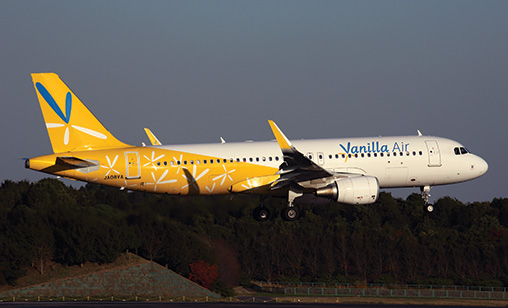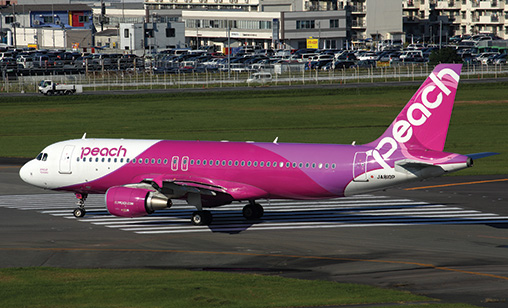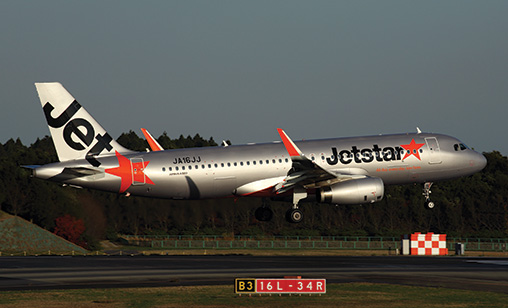Low-Cost Carriers
Sleeping LCC giant awakens
It has taken time, but Japan’s low-cost carriers are catching up with the Asia-Pacific budget airline boom as they make serious inroads into the domestic and international traffic of full service airlines.
April 1st 2017
Japan has been a sleeping giant when it comes to no-frills air travel. Conservative Japanese airline passengers would never take up budget travel, said any number of analysts. Read More » But they are being proven wrong. In the last three years, Japan’s low-cost carrier (LCC) market has been catching up with its regional rivals and also winning market share from full service carriers.
As 2017 got underway, LCCs were operating 16% of all scheduled capacity in Japan. On current growth trajectories, they may end the year with a 20% share of the nation’s airline market, reported scheduling consultancy, OAG.
 |
 |
 |
Last year, LCC capacity in Japan was split almost evenly between domestic and international routes, a consequence of strong LCC growth between Japan and its major international markets and a plateauing at domestic LCCs, OAG said.
By year end, LCCs had around 18% of international scheduled seats - up from 9% two years ago - and 15% of domestic seats. At press time, 22 LCCs were flying into and out of Japan offering annual capacity of around 18.5 million seats. Seven domestic LCCs share capacity of 22 million seats.
“There’s been an LCC presence in Japan for many years but for much of that time, they failed to create the market disruption that took place in Malaysia, Brazil and the UK. At last, LCCs in Japan are tracking the same growth in market share that has occurred elsewhere, albeit ten years earlier,” said OAG.
The report was released as ANA HOLDINGS, the parent of All Nippon Airways, announced it would spend US$270 million to increase its shareholding in LCC, Peach Aviation, from 38.7% to 67%. The share transfer from other joint venture partners in the six-year-old LCC is a sure sign Japan’s biggest full-service airline group wants to strengthen its position in the budget sector.
At Jetstar Japan, jointly owned by Japan Airlines (JAL) and the Qantas Group, the LCC is upping the competitive ante. Qantas Group CEO, Alan Joyce, said recently he was very focused on new means for Qantas to extract profit from the business. “We think Japan is one that is the case. We are adding a significant amount of capacity in the Japanese market,” he said.
Profitable Jetstar holds 53% of the domestic LCC market in Japan. “It has the best brand in Japan for low-cost carriers and the best customer service. There are so many opportunities for us up there,” he said.
ANA HOLDINGS chief executive, Shinya Katanozaka, said Peach’s shareholders decided on consolidation as the best way to accelerate the growth of Osaka-based LCC.
“Since Peach launched in 2011, it has become a driving force in Japan’s LCC market. We are proud to support the acceleration of its growth across Asia. Peach is a key component of ANA HOLDINGS’s strategy. It provides customers with greater travel choices, expands our network and enables us to better serve the increasing numbers of tourists visiting Japan,’’ he said.
Nevertheless, Peach and Jetstar Japan won’t have it all their own way. Five other LCCs - Solaseed, Vanilla Air, Spring Airlines Japan, Skymark and SkyFlyer - operate in the market.
Jetstar dominates Tokyo’s Narita airport and Peach leads at Osaka/Kansai. Apart from increasing its holding in Peach, ANA HOLDINGS has equity in Solaseed and Skymark, although some industry analysts don’t regard Skymark as an LCC, and ANAH fully controls Vanilla Air.
In an investor guidance note, SMBC Nikko Securities analyst, Hiroshi Hasegawa, said: “We take the move by ANA management as a positive step to bring a second major LLC under its wing, which would give it more leverage and flexibility, including a possible Peach merger with Vanilla.”
While growth is forecast for the sector, OAG said there also are reservations about forecast market expansion. Overall capacity growth in Japan moderated last year and OAG questioned the ability of LCCs to stimulate travel in the mature Japanese market.
| 'Unlike the domestic market, characterized by Japan’s dominant carriers which, in one guise or another, have a strong grip on capacity growth, Japan’s international capacity seems set to continue to grow apace, driven by competing foreign carriers' |
| OAG report on Japanese low-cost carrier growth |
“LCCs are either 100% owned by ANA or JAL or these two carriers have a equity stakes in them. This acts to effectively put a brake on aggressive LCC expansion, given the downward pressure on fares that LCC growth causes and the potential impact of their presence on the dominant full service carriers in the domestic market. In the last year, growth has stagnated and this may continue.”
The only LCC operating in Japan that is not linked to ANA or JAL is Spring Airlines Japan, a subsidiary of Chinese budget carrier group, Spring Airlines. Spring Airlines Japan has a relatively small domestic market share, but its Mainland parent’s goal is to double passengers carried between Japan and China by 2022, at a rate of 1.25 million passengers a year.
Peach, the third largest LCC in Japan, has committed to purchase 10 A320neo and three A320ceo to add to its fleet of A320s. By doubling its fleet, Peach may have international routes in mind for the new aircraft, rather than servicing domestic destinations.
OAG said international capacity would continue to strengthen, especially among LCCs, given average annual growth of LCC capacity has been 55% since 2010. Last year, International LCC capacity expanded by 51% and four LCCs entered the market. However, less than a quarter of low-cost capacity - just 22% - is operated by Japanese airlines. Peach is the largest LCC flying international routes to and from Japan, with a 12% share of low cost seats and capacity expansion of 44% in 2016.
The next largest international LCC in Japan is South Korea’s Jeju Airlines. Along with other South Korean airlines - Air Busan, Jin Air, T’way Air and Air Seoul - they operate 29% of LCC seats to and from Japan. Jeju Airlines achieved bigger growth than Peach, with 45% more seats in 2016 than it flew in 2015.